Detailed Case Study: Angina Pectoris, Patient History and Treatment
VerifiedAdded on 2023/06/13
|14
|3784
|82
Case Study
AI Summary
This case study provides a comprehensive overview of Angina Pectoris, focusing on a patient named Rainey who presented with chest pain radiating to the neck and jaw. The study includes a detailed health history, cardiovascular and peripheral vascular system assessments, and an analysis of subjective and objective data. The pathophysiology explains the development of atherosclerosis due to Rainey's sedentary lifestyle and high-fat diet, leading to ischemia and angina pectoris. The plan of care addresses cholesterol abnormalities, chest pain relief, ineffective tissue perfusion, and anxiety management. Medical management includes thrombolytic administration and medication such as nitroglycerin, beta-blockers, and aspirin. The study emphasizes the importance of oxygen therapy, physical rest, and cardiac rehabilitation to improve patient outcomes. Desklib offers this and many other solved assignments to aid students in their studies.

Running header: ANGINA PECTORIS 1
Angina pectoris
Student’s name
Institutional
Angina pectoris
Student’s name
Institutional
Paraphrase This Document
Need a fresh take? Get an instant paraphrase of this document with our AI Paraphraser
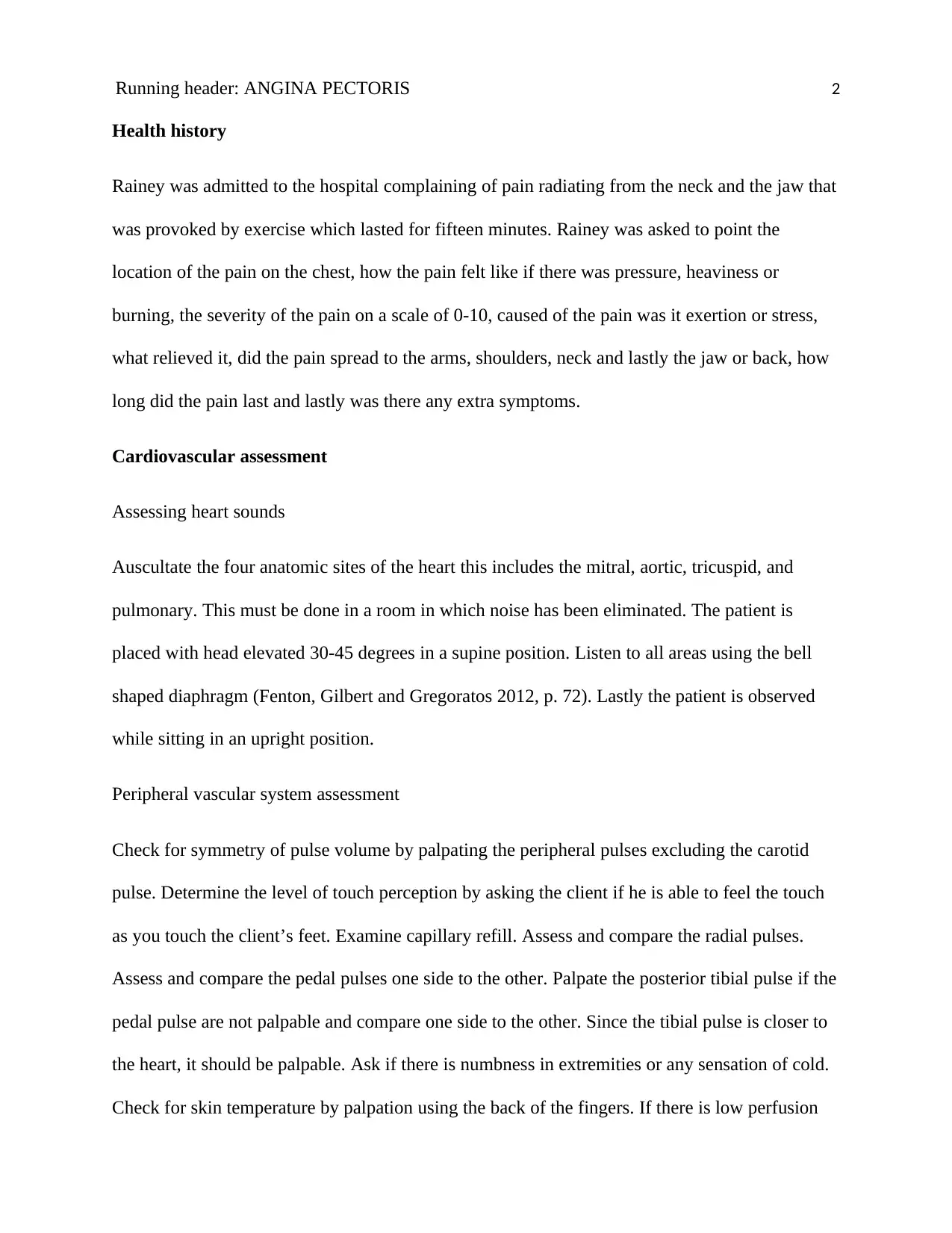
Running header: ANGINA PECTORIS 2
Health history
Rainey was admitted to the hospital complaining of pain radiating from the neck and the jaw that
was provoked by exercise which lasted for fifteen minutes. Rainey was asked to point the
location of the pain on the chest, how the pain felt like if there was pressure, heaviness or
burning, the severity of the pain on a scale of 0-10, caused of the pain was it exertion or stress,
what relieved it, did the pain spread to the arms, shoulders, neck and lastly the jaw or back, how
long did the pain last and lastly was there any extra symptoms.
Cardiovascular assessment
Assessing heart sounds
Auscultate the four anatomic sites of the heart this includes the mitral, aortic, tricuspid, and
pulmonary. This must be done in a room in which noise has been eliminated. The patient is
placed with head elevated 30-45 degrees in a supine position. Listen to all areas using the bell
shaped diaphragm (Fenton, Gilbert and Gregoratos 2012, p. 72). Lastly the patient is observed
while sitting in an upright position.
Peripheral vascular system assessment
Check for symmetry of pulse volume by palpating the peripheral pulses excluding the carotid
pulse. Determine the level of touch perception by asking the client if he is able to feel the touch
as you touch the client’s feet. Examine capillary refill. Assess and compare the radial pulses.
Assess and compare the pedal pulses one side to the other. Palpate the posterior tibial pulse if the
pedal pulse are not palpable and compare one side to the other. Since the tibial pulse is closer to
the heart, it should be palpable. Ask if there is numbness in extremities or any sensation of cold.
Check for skin temperature by palpation using the back of the fingers. If there is low perfusion
Health history
Rainey was admitted to the hospital complaining of pain radiating from the neck and the jaw that
was provoked by exercise which lasted for fifteen minutes. Rainey was asked to point the
location of the pain on the chest, how the pain felt like if there was pressure, heaviness or
burning, the severity of the pain on a scale of 0-10, caused of the pain was it exertion or stress,
what relieved it, did the pain spread to the arms, shoulders, neck and lastly the jaw or back, how
long did the pain last and lastly was there any extra symptoms.
Cardiovascular assessment
Assessing heart sounds
Auscultate the four anatomic sites of the heart this includes the mitral, aortic, tricuspid, and
pulmonary. This must be done in a room in which noise has been eliminated. The patient is
placed with head elevated 30-45 degrees in a supine position. Listen to all areas using the bell
shaped diaphragm (Fenton, Gilbert and Gregoratos 2012, p. 72). Lastly the patient is observed
while sitting in an upright position.
Peripheral vascular system assessment
Check for symmetry of pulse volume by palpating the peripheral pulses excluding the carotid
pulse. Determine the level of touch perception by asking the client if he is able to feel the touch
as you touch the client’s feet. Examine capillary refill. Assess and compare the radial pulses.
Assess and compare the pedal pulses one side to the other. Palpate the posterior tibial pulse if the
pedal pulse are not palpable and compare one side to the other. Since the tibial pulse is closer to
the heart, it should be palpable. Ask if there is numbness in extremities or any sensation of cold.
Check for skin temperature by palpation using the back of the fingers. If there is low perfusion
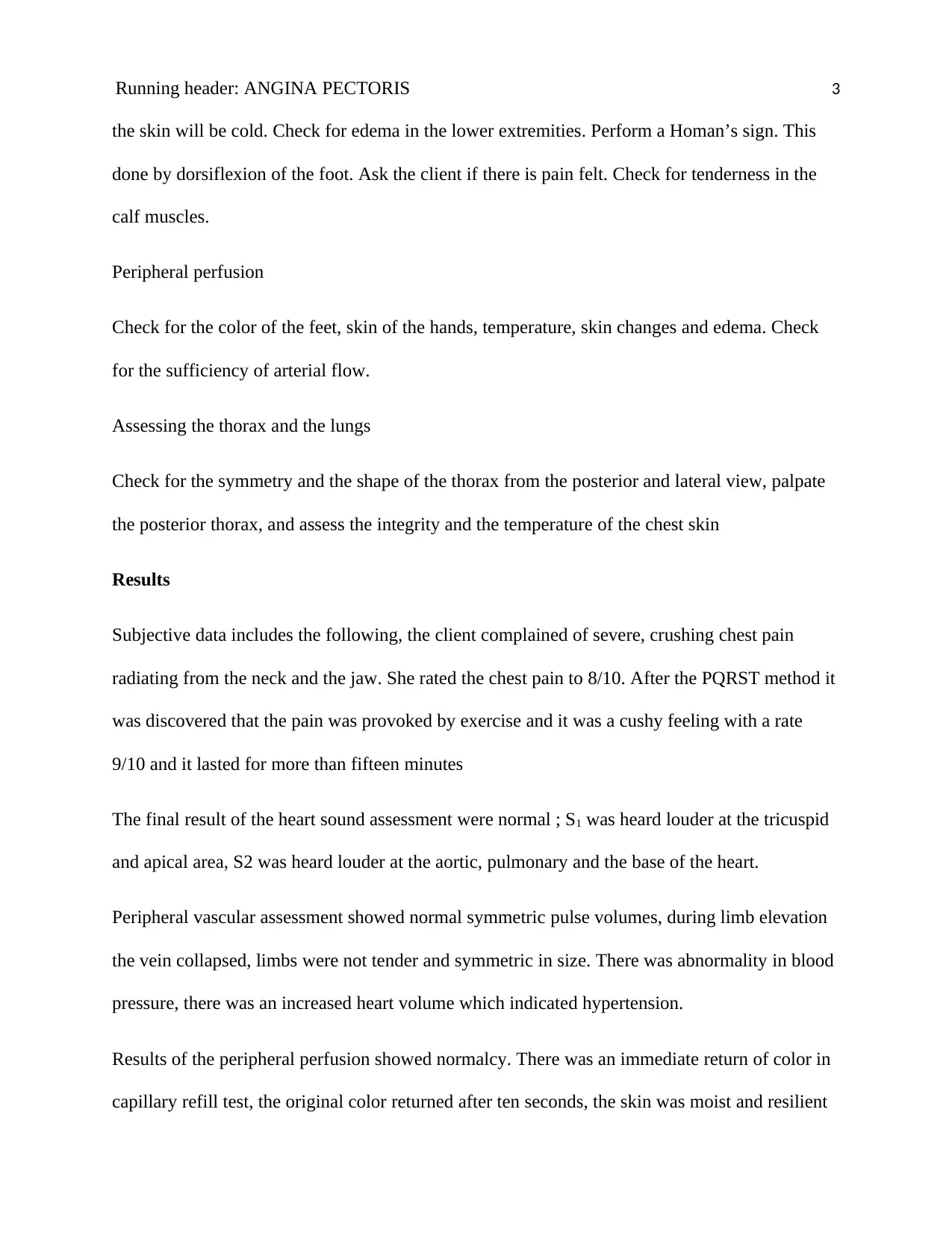
Running header: ANGINA PECTORIS 3
the skin will be cold. Check for edema in the lower extremities. Perform a Homan’s sign. This
done by dorsiflexion of the foot. Ask the client if there is pain felt. Check for tenderness in the
calf muscles.
Peripheral perfusion
Check for the color of the feet, skin of the hands, temperature, skin changes and edema. Check
for the sufficiency of arterial flow.
Assessing the thorax and the lungs
Check for the symmetry and the shape of the thorax from the posterior and lateral view, palpate
the posterior thorax, and assess the integrity and the temperature of the chest skin
Results
Subjective data includes the following, the client complained of severe, crushing chest pain
radiating from the neck and the jaw. She rated the chest pain to 8/10. After the PQRST method it
was discovered that the pain was provoked by exercise and it was a cushy feeling with a rate
9/10 and it lasted for more than fifteen minutes
The final result of the heart sound assessment were normal ; S1 was heard louder at the tricuspid
and apical area, S2 was heard louder at the aortic, pulmonary and the base of the heart.
Peripheral vascular assessment showed normal symmetric pulse volumes, during limb elevation
the vein collapsed, limbs were not tender and symmetric in size. There was abnormality in blood
pressure, there was an increased heart volume which indicated hypertension.
Results of the peripheral perfusion showed normalcy. There was an immediate return of color in
capillary refill test, the original color returned after ten seconds, the skin was moist and resilient
the skin will be cold. Check for edema in the lower extremities. Perform a Homan’s sign. This
done by dorsiflexion of the foot. Ask the client if there is pain felt. Check for tenderness in the
calf muscles.
Peripheral perfusion
Check for the color of the feet, skin of the hands, temperature, skin changes and edema. Check
for the sufficiency of arterial flow.
Assessing the thorax and the lungs
Check for the symmetry and the shape of the thorax from the posterior and lateral view, palpate
the posterior thorax, and assess the integrity and the temperature of the chest skin
Results
Subjective data includes the following, the client complained of severe, crushing chest pain
radiating from the neck and the jaw. She rated the chest pain to 8/10. After the PQRST method it
was discovered that the pain was provoked by exercise and it was a cushy feeling with a rate
9/10 and it lasted for more than fifteen minutes
The final result of the heart sound assessment were normal ; S1 was heard louder at the tricuspid
and apical area, S2 was heard louder at the aortic, pulmonary and the base of the heart.
Peripheral vascular assessment showed normal symmetric pulse volumes, during limb elevation
the vein collapsed, limbs were not tender and symmetric in size. There was abnormality in blood
pressure, there was an increased heart volume which indicated hypertension.
Results of the peripheral perfusion showed normalcy. There was an immediate return of color in
capillary refill test, the original color returned after ten seconds, the skin was moist and resilient
⊘ This is a preview!⊘
Do you want full access?
Subscribe today to unlock all pages.

Trusted by 1+ million students worldwide
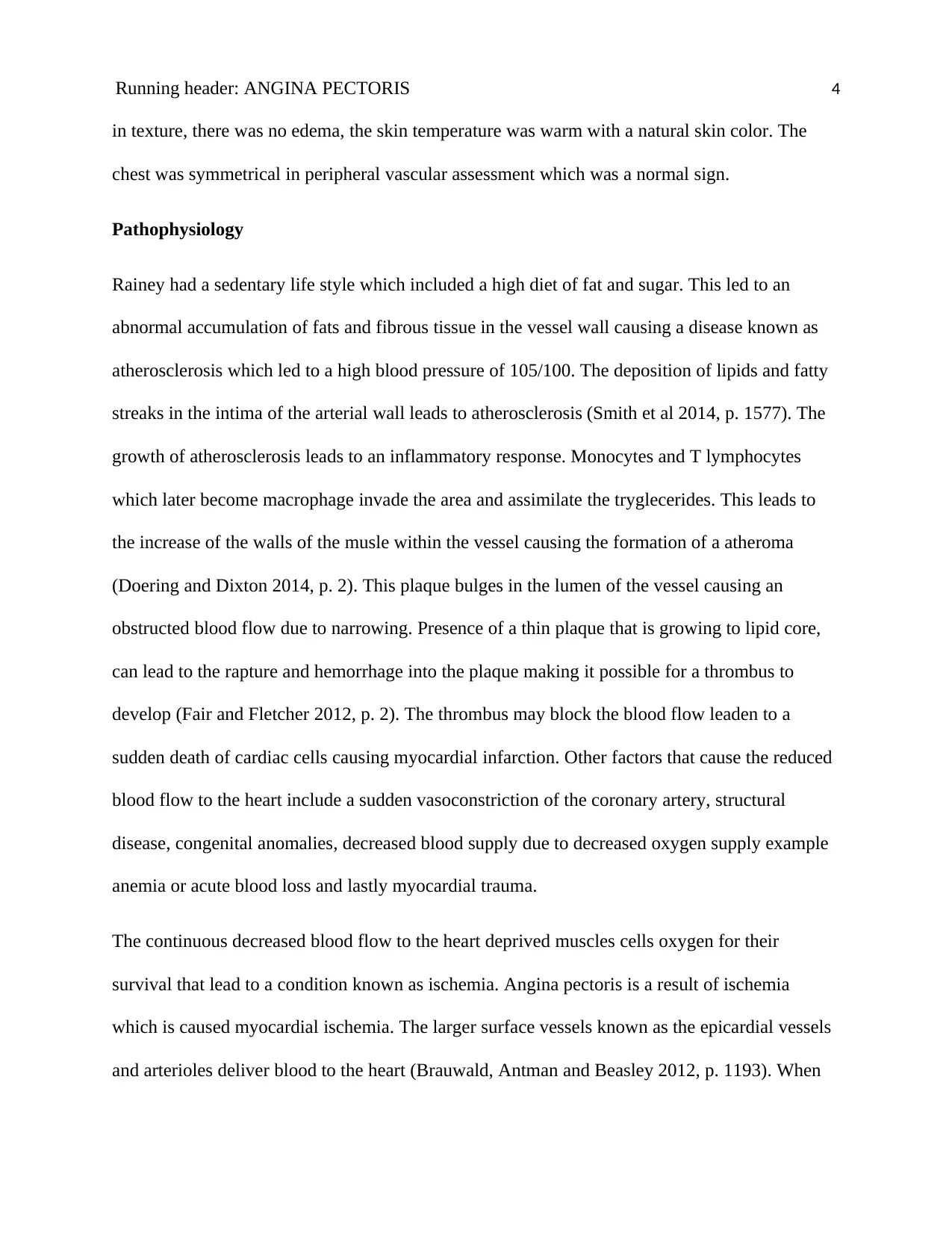
Running header: ANGINA PECTORIS 4
in texture, there was no edema, the skin temperature was warm with a natural skin color. The
chest was symmetrical in peripheral vascular assessment which was a normal sign.
Pathophysiology
Rainey had a sedentary life style which included a high diet of fat and sugar. This led to an
abnormal accumulation of fats and fibrous tissue in the vessel wall causing a disease known as
atherosclerosis which led to a high blood pressure of 105/100. The deposition of lipids and fatty
streaks in the intima of the arterial wall leads to atherosclerosis (Smith et al 2014, p. 1577). The
growth of atherosclerosis leads to an inflammatory response. Monocytes and T lymphocytes
which later become macrophage invade the area and assimilate the tryglecerides. This leads to
the increase of the walls of the musle within the vessel causing the formation of a atheroma
(Doering and Dixton 2014, p. 2). This plaque bulges in the lumen of the vessel causing an
obstructed blood flow due to narrowing. Presence of a thin plaque that is growing to lipid core,
can lead to the rapture and hemorrhage into the plaque making it possible for a thrombus to
develop (Fair and Fletcher 2012, p. 2). The thrombus may block the blood flow leaden to a
sudden death of cardiac cells causing myocardial infarction. Other factors that cause the reduced
blood flow to the heart include a sudden vasoconstriction of the coronary artery, structural
disease, congenital anomalies, decreased blood supply due to decreased oxygen supply example
anemia or acute blood loss and lastly myocardial trauma.
The continuous decreased blood flow to the heart deprived muscles cells oxygen for their
survival that lead to a condition known as ischemia. Angina pectoris is a result of ischemia
which is caused myocardial ischemia. The larger surface vessels known as the epicardial vessels
and arterioles deliver blood to the heart (Brauwald, Antman and Beasley 2012, p. 1193). When
in texture, there was no edema, the skin temperature was warm with a natural skin color. The
chest was symmetrical in peripheral vascular assessment which was a normal sign.
Pathophysiology
Rainey had a sedentary life style which included a high diet of fat and sugar. This led to an
abnormal accumulation of fats and fibrous tissue in the vessel wall causing a disease known as
atherosclerosis which led to a high blood pressure of 105/100. The deposition of lipids and fatty
streaks in the intima of the arterial wall leads to atherosclerosis (Smith et al 2014, p. 1577). The
growth of atherosclerosis leads to an inflammatory response. Monocytes and T lymphocytes
which later become macrophage invade the area and assimilate the tryglecerides. This leads to
the increase of the walls of the musle within the vessel causing the formation of a atheroma
(Doering and Dixton 2014, p. 2). This plaque bulges in the lumen of the vessel causing an
obstructed blood flow due to narrowing. Presence of a thin plaque that is growing to lipid core,
can lead to the rapture and hemorrhage into the plaque making it possible for a thrombus to
develop (Fair and Fletcher 2012, p. 2). The thrombus may block the blood flow leaden to a
sudden death of cardiac cells causing myocardial infarction. Other factors that cause the reduced
blood flow to the heart include a sudden vasoconstriction of the coronary artery, structural
disease, congenital anomalies, decreased blood supply due to decreased oxygen supply example
anemia or acute blood loss and lastly myocardial trauma.
The continuous decreased blood flow to the heart deprived muscles cells oxygen for their
survival that lead to a condition known as ischemia. Angina pectoris is a result of ischemia
which is caused myocardial ischemia. The larger surface vessels known as the epicardial vessels
and arterioles deliver blood to the heart (Brauwald, Antman and Beasley 2012, p. 1193). When
Paraphrase This Document
Need a fresh take? Get an instant paraphrase of this document with our AI Paraphraser
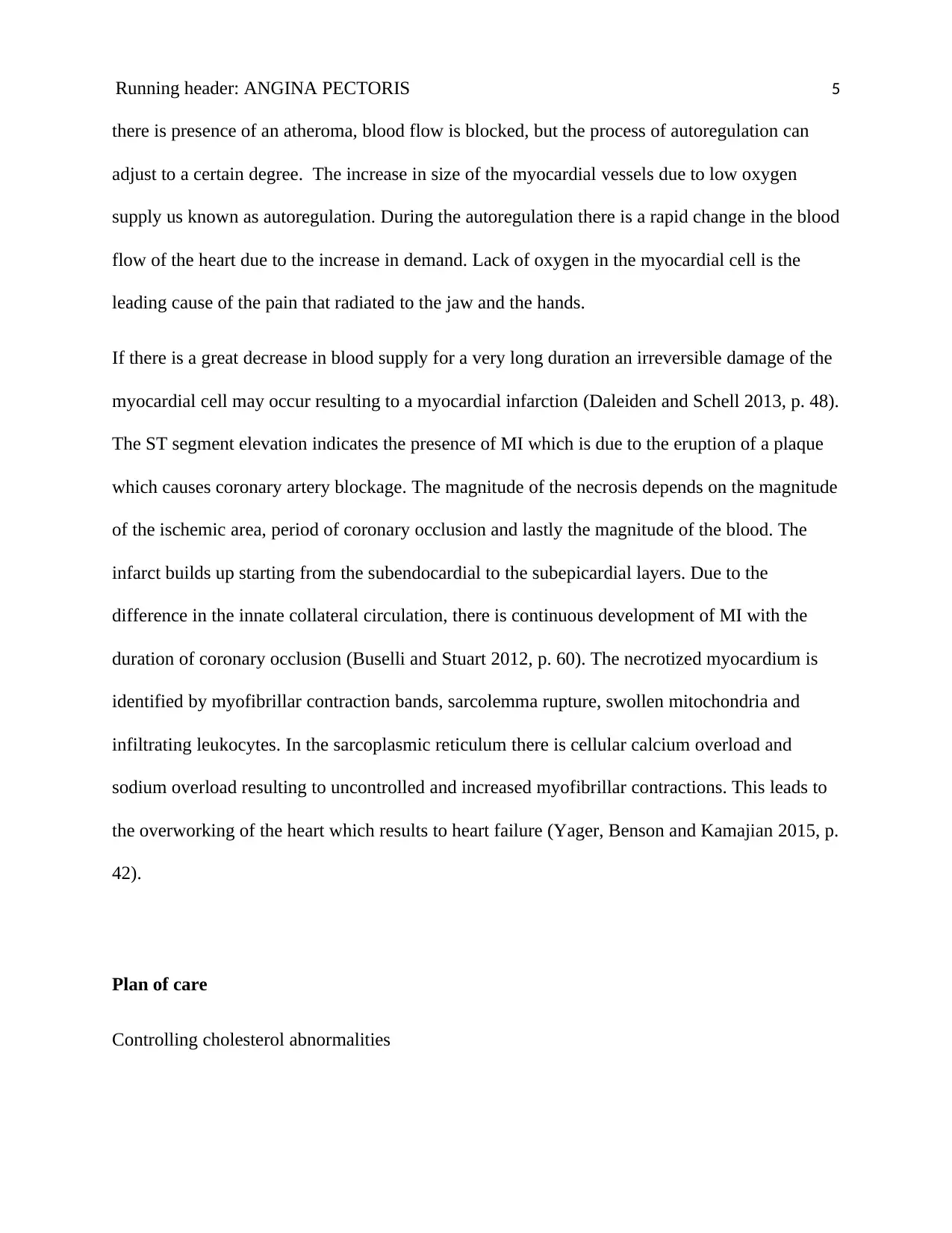
Running header: ANGINA PECTORIS 5
there is presence of an atheroma, blood flow is blocked, but the process of autoregulation can
adjust to a certain degree. The increase in size of the myocardial vessels due to low oxygen
supply us known as autoregulation. During the autoregulation there is a rapid change in the blood
flow of the heart due to the increase in demand. Lack of oxygen in the myocardial cell is the
leading cause of the pain that radiated to the jaw and the hands.
If there is a great decrease in blood supply for a very long duration an irreversible damage of the
myocardial cell may occur resulting to a myocardial infarction (Daleiden and Schell 2013, p. 48).
The ST segment elevation indicates the presence of MI which is due to the eruption of a plaque
which causes coronary artery blockage. The magnitude of the necrosis depends on the magnitude
of the ischemic area, period of coronary occlusion and lastly the magnitude of the blood. The
infarct builds up starting from the subendocardial to the subepicardial layers. Due to the
difference in the innate collateral circulation, there is continuous development of MI with the
duration of coronary occlusion (Buselli and Stuart 2012, p. 60). The necrotized myocardium is
identified by myofibrillar contraction bands, sarcolemma rupture, swollen mitochondria and
infiltrating leukocytes. In the sarcoplasmic reticulum there is cellular calcium overload and
sodium overload resulting to uncontrolled and increased myofibrillar contractions. This leads to
the overworking of the heart which results to heart failure (Yager, Benson and Kamajian 2015, p.
42).
Plan of care
Controlling cholesterol abnormalities
there is presence of an atheroma, blood flow is blocked, but the process of autoregulation can
adjust to a certain degree. The increase in size of the myocardial vessels due to low oxygen
supply us known as autoregulation. During the autoregulation there is a rapid change in the blood
flow of the heart due to the increase in demand. Lack of oxygen in the myocardial cell is the
leading cause of the pain that radiated to the jaw and the hands.
If there is a great decrease in blood supply for a very long duration an irreversible damage of the
myocardial cell may occur resulting to a myocardial infarction (Daleiden and Schell 2013, p. 48).
The ST segment elevation indicates the presence of MI which is due to the eruption of a plaque
which causes coronary artery blockage. The magnitude of the necrosis depends on the magnitude
of the ischemic area, period of coronary occlusion and lastly the magnitude of the blood. The
infarct builds up starting from the subendocardial to the subepicardial layers. Due to the
difference in the innate collateral circulation, there is continuous development of MI with the
duration of coronary occlusion (Buselli and Stuart 2012, p. 60). The necrotized myocardium is
identified by myofibrillar contraction bands, sarcolemma rupture, swollen mitochondria and
infiltrating leukocytes. In the sarcoplasmic reticulum there is cellular calcium overload and
sodium overload resulting to uncontrolled and increased myofibrillar contractions. This leads to
the overworking of the heart which results to heart failure (Yager, Benson and Kamajian 2015, p.
42).
Plan of care
Controlling cholesterol abnormalities
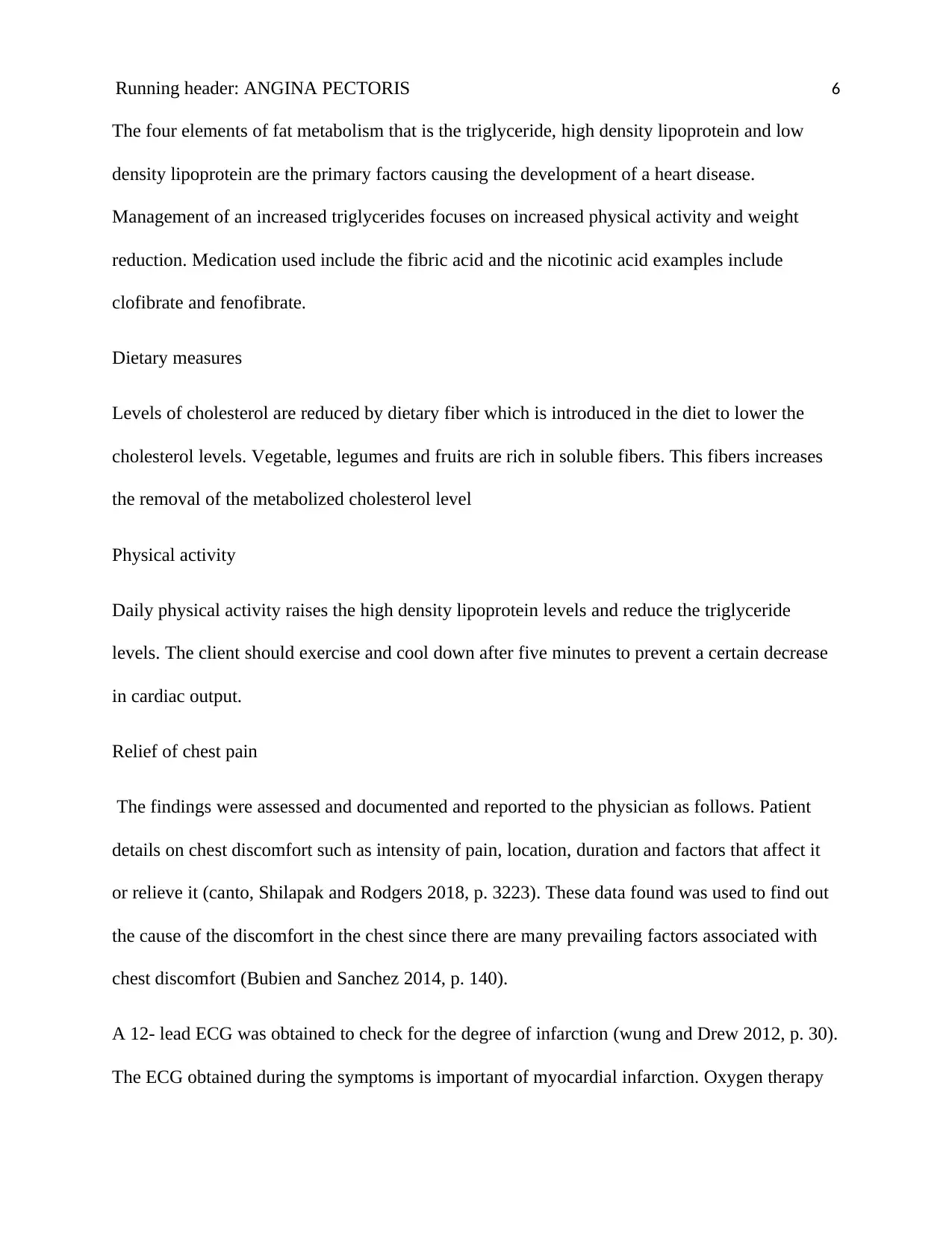
Running header: ANGINA PECTORIS 6
The four elements of fat metabolism that is the triglyceride, high density lipoprotein and low
density lipoprotein are the primary factors causing the development of a heart disease.
Management of an increased triglycerides focuses on increased physical activity and weight
reduction. Medication used include the fibric acid and the nicotinic acid examples include
clofibrate and fenofibrate.
Dietary measures
Levels of cholesterol are reduced by dietary fiber which is introduced in the diet to lower the
cholesterol levels. Vegetable, legumes and fruits are rich in soluble fibers. This fibers increases
the removal of the metabolized cholesterol level
Physical activity
Daily physical activity raises the high density lipoprotein levels and reduce the triglyceride
levels. The client should exercise and cool down after five minutes to prevent a certain decrease
in cardiac output.
Relief of chest pain
The findings were assessed and documented and reported to the physician as follows. Patient
details on chest discomfort such as intensity of pain, location, duration and factors that affect it
or relieve it (canto, Shilapak and Rodgers 2018, p. 3223). These data found was used to find out
the cause of the discomfort in the chest since there are many prevailing factors associated with
chest discomfort (Bubien and Sanchez 2014, p. 140).
A 12- lead ECG was obtained to check for the degree of infarction (wung and Drew 2012, p. 30).
The ECG obtained during the symptoms is important of myocardial infarction. Oxygen therapy
The four elements of fat metabolism that is the triglyceride, high density lipoprotein and low
density lipoprotein are the primary factors causing the development of a heart disease.
Management of an increased triglycerides focuses on increased physical activity and weight
reduction. Medication used include the fibric acid and the nicotinic acid examples include
clofibrate and fenofibrate.
Dietary measures
Levels of cholesterol are reduced by dietary fiber which is introduced in the diet to lower the
cholesterol levels. Vegetable, legumes and fruits are rich in soluble fibers. This fibers increases
the removal of the metabolized cholesterol level
Physical activity
Daily physical activity raises the high density lipoprotein levels and reduce the triglyceride
levels. The client should exercise and cool down after five minutes to prevent a certain decrease
in cardiac output.
Relief of chest pain
The findings were assessed and documented and reported to the physician as follows. Patient
details on chest discomfort such as intensity of pain, location, duration and factors that affect it
or relieve it (canto, Shilapak and Rodgers 2018, p. 3223). These data found was used to find out
the cause of the discomfort in the chest since there are many prevailing factors associated with
chest discomfort (Bubien and Sanchez 2014, p. 140).
A 12- lead ECG was obtained to check for the degree of infarction (wung and Drew 2012, p. 30).
The ECG obtained during the symptoms is important of myocardial infarction. Oxygen therapy
⊘ This is a preview!⊘
Do you want full access?
Subscribe today to unlock all pages.

Trusted by 1+ million students worldwide

Running header: ANGINA PECTORIS 7
was administered, this kind of therapy is used to supply oxygen when oxygen transport to the
myocardium is lesser than normal. Physical rest was emphasized: bedside commode was used
with assistance, during activity arms of the upper extremities were supported, stool softener was
used to prevent too much straining, and supportive care was provided to ease fear and anxiety.
Physical rest decreases the intake of myocardial oxygen. Anxiety and fear bring about a stress
response which leads to the secretion of endogenous catecholamine’s this leads to an increase of
myocardial oxygen intake. Epinephrine increase also causes a decreased pain threshold which in
turn increase myocardial oxygen consumption.
Ineffective tissue perfusion
After every four hours the patient was accessed for urine output, activity intolerance, tachycardia
and hypotension. The state of the cardiac output is obtained by collecting this information
appropriately. Variant angina, infarction and myocardial ischemia diagnosis is important for a
ECG with pain (Dougherty, Benoliel and Bellin 2012, p. 79).
Relief of anxiety
The patient and families level of anxiety was accessed and documented. These information was
used to provide the patient psychological well-being so as the post- therapy symptoms can be
compared (Biselli and Stuart 2012, p. 66). Anxiety problems are capable to change, this changes
may be inform of pain or severe illness. Since members of the family can transfer anxiety to the
client, strategies are identified to lessen the family members fear and anxiety (Bosworth et al
2014, p.17). The need for spiritual cancelling is accessed, religion support may helping reducing
anxiety and fear. The client is given consent to convey anxiety and fear by facilitating
communication and also by answering questions. Unresolved anxiety leads to an increase in
was administered, this kind of therapy is used to supply oxygen when oxygen transport to the
myocardium is lesser than normal. Physical rest was emphasized: bedside commode was used
with assistance, during activity arms of the upper extremities were supported, stool softener was
used to prevent too much straining, and supportive care was provided to ease fear and anxiety.
Physical rest decreases the intake of myocardial oxygen. Anxiety and fear bring about a stress
response which leads to the secretion of endogenous catecholamine’s this leads to an increase of
myocardial oxygen intake. Epinephrine increase also causes a decreased pain threshold which in
turn increase myocardial oxygen consumption.
Ineffective tissue perfusion
After every four hours the patient was accessed for urine output, activity intolerance, tachycardia
and hypotension. The state of the cardiac output is obtained by collecting this information
appropriately. Variant angina, infarction and myocardial ischemia diagnosis is important for a
ECG with pain (Dougherty, Benoliel and Bellin 2012, p. 79).
Relief of anxiety
The patient and families level of anxiety was accessed and documented. These information was
used to provide the patient psychological well-being so as the post- therapy symptoms can be
compared (Biselli and Stuart 2012, p. 66). Anxiety problems are capable to change, this changes
may be inform of pain or severe illness. Since members of the family can transfer anxiety to the
client, strategies are identified to lessen the family members fear and anxiety (Bosworth et al
2014, p.17). The need for spiritual cancelling is accessed, religion support may helping reducing
anxiety and fear. The client is given consent to convey anxiety and fear by facilitating
communication and also by answering questions. Unresolved anxiety leads to an increase in
Paraphrase This Document
Need a fresh take? Get an instant paraphrase of this document with our AI Paraphraser
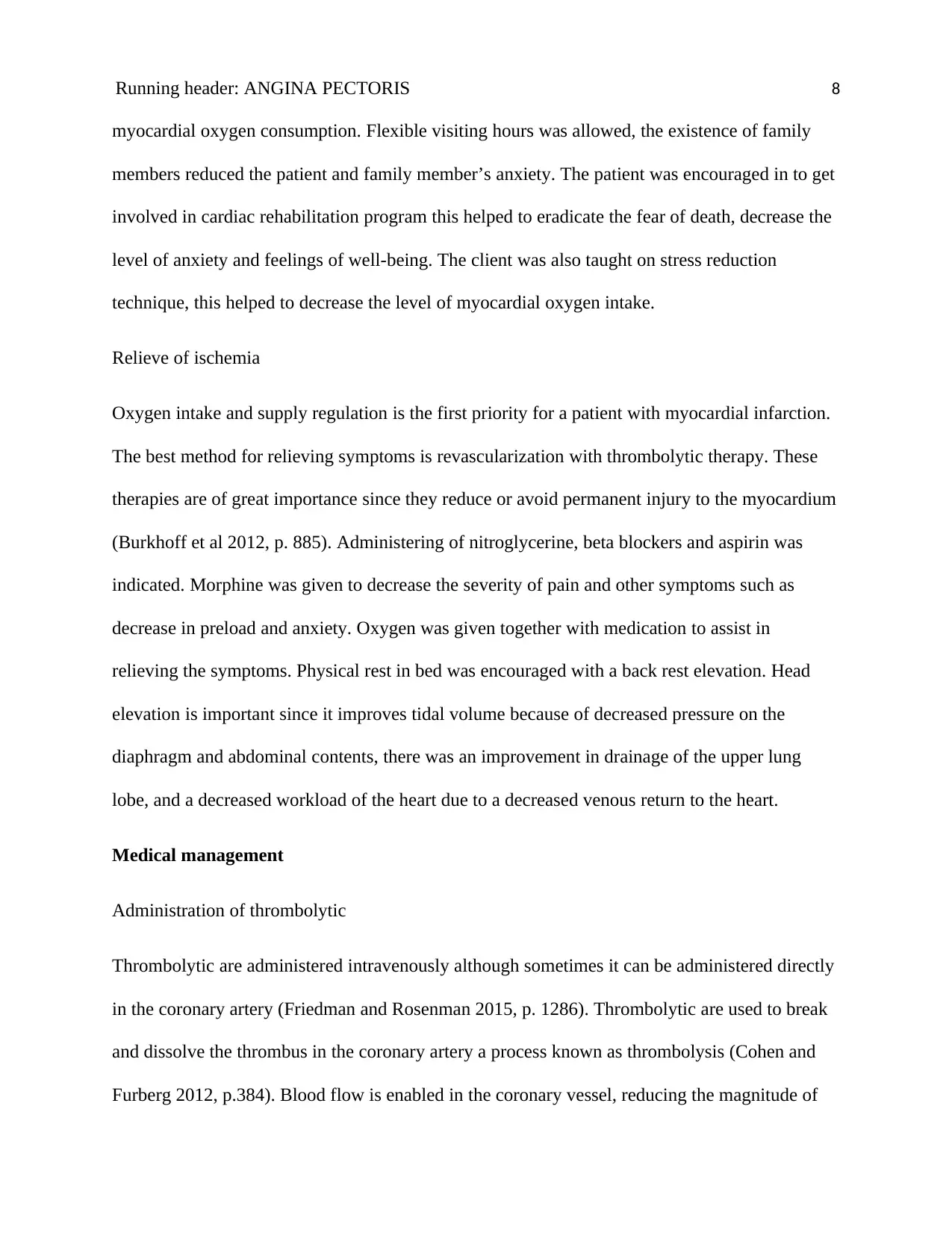
Running header: ANGINA PECTORIS 8
myocardial oxygen consumption. Flexible visiting hours was allowed, the existence of family
members reduced the patient and family member’s anxiety. The patient was encouraged in to get
involved in cardiac rehabilitation program this helped to eradicate the fear of death, decrease the
level of anxiety and feelings of well-being. The client was also taught on stress reduction
technique, this helped to decrease the level of myocardial oxygen intake.
Relieve of ischemia
Oxygen intake and supply regulation is the first priority for a patient with myocardial infarction.
The best method for relieving symptoms is revascularization with thrombolytic therapy. These
therapies are of great importance since they reduce or avoid permanent injury to the myocardium
(Burkhoff et al 2012, p. 885). Administering of nitroglycerine, beta blockers and aspirin was
indicated. Morphine was given to decrease the severity of pain and other symptoms such as
decrease in preload and anxiety. Oxygen was given together with medication to assist in
relieving the symptoms. Physical rest in bed was encouraged with a back rest elevation. Head
elevation is important since it improves tidal volume because of decreased pressure on the
diaphragm and abdominal contents, there was an improvement in drainage of the upper lung
lobe, and a decreased workload of the heart due to a decreased venous return to the heart.
Medical management
Administration of thrombolytic
Thrombolytic are administered intravenously although sometimes it can be administered directly
in the coronary artery (Friedman and Rosenman 2015, p. 1286). Thrombolytic are used to break
and dissolve the thrombus in the coronary artery a process known as thrombolysis (Cohen and
Furberg 2012, p.384). Blood flow is enabled in the coronary vessel, reducing the magnitude of
myocardial oxygen consumption. Flexible visiting hours was allowed, the existence of family
members reduced the patient and family member’s anxiety. The patient was encouraged in to get
involved in cardiac rehabilitation program this helped to eradicate the fear of death, decrease the
level of anxiety and feelings of well-being. The client was also taught on stress reduction
technique, this helped to decrease the level of myocardial oxygen intake.
Relieve of ischemia
Oxygen intake and supply regulation is the first priority for a patient with myocardial infarction.
The best method for relieving symptoms is revascularization with thrombolytic therapy. These
therapies are of great importance since they reduce or avoid permanent injury to the myocardium
(Burkhoff et al 2012, p. 885). Administering of nitroglycerine, beta blockers and aspirin was
indicated. Morphine was given to decrease the severity of pain and other symptoms such as
decrease in preload and anxiety. Oxygen was given together with medication to assist in
relieving the symptoms. Physical rest in bed was encouraged with a back rest elevation. Head
elevation is important since it improves tidal volume because of decreased pressure on the
diaphragm and abdominal contents, there was an improvement in drainage of the upper lung
lobe, and a decreased workload of the heart due to a decreased venous return to the heart.
Medical management
Administration of thrombolytic
Thrombolytic are administered intravenously although sometimes it can be administered directly
in the coronary artery (Friedman and Rosenman 2015, p. 1286). Thrombolytic are used to break
and dissolve the thrombus in the coronary artery a process known as thrombolysis (Cohen and
Furberg 2012, p.384). Blood flow is enabled in the coronary vessel, reducing the magnitude of
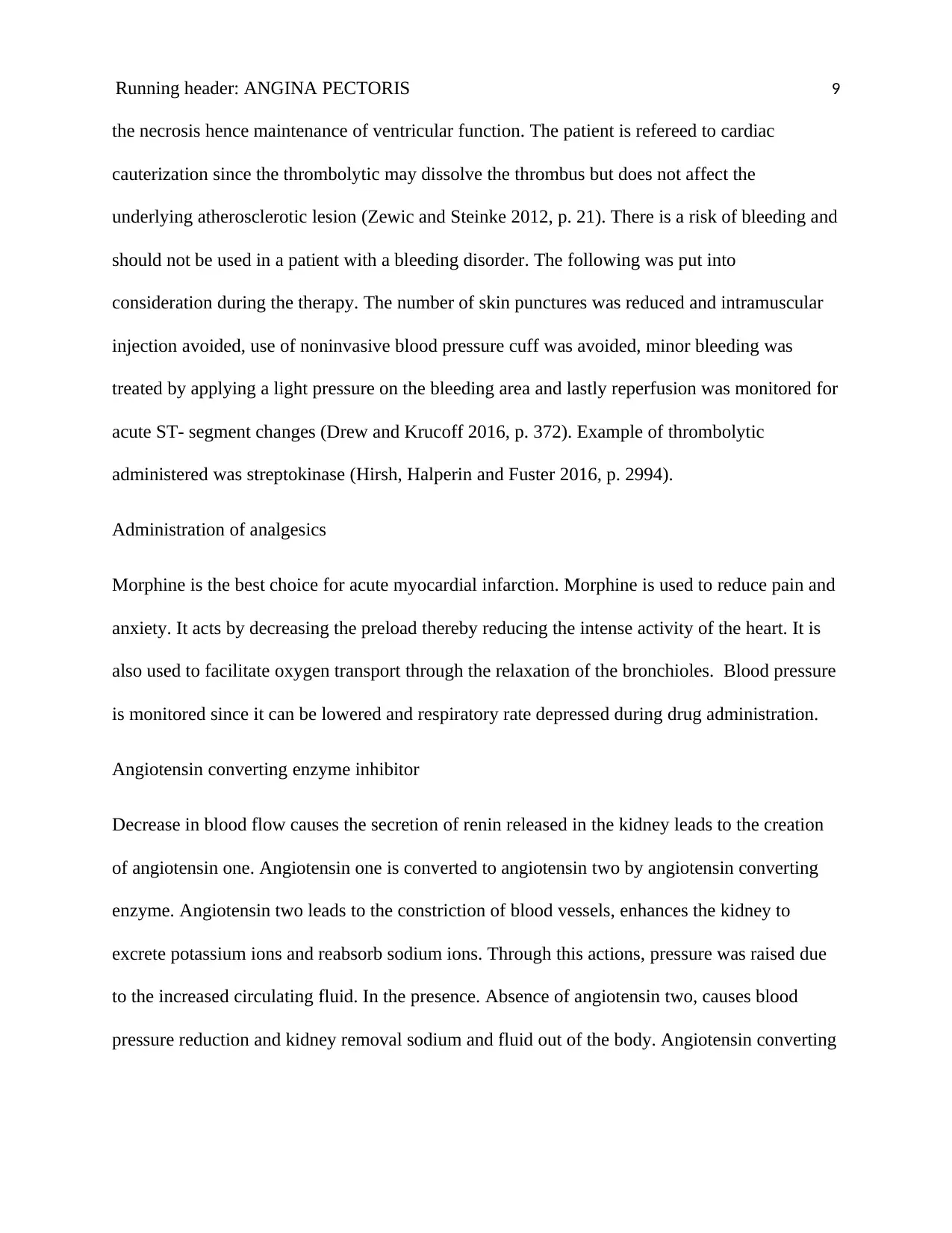
Running header: ANGINA PECTORIS 9
the necrosis hence maintenance of ventricular function. The patient is refereed to cardiac
cauterization since the thrombolytic may dissolve the thrombus but does not affect the
underlying atherosclerotic lesion (Zewic and Steinke 2012, p. 21). There is a risk of bleeding and
should not be used in a patient with a bleeding disorder. The following was put into
consideration during the therapy. The number of skin punctures was reduced and intramuscular
injection avoided, use of noninvasive blood pressure cuff was avoided, minor bleeding was
treated by applying a light pressure on the bleeding area and lastly reperfusion was monitored for
acute ST- segment changes (Drew and Krucoff 2016, p. 372). Example of thrombolytic
administered was streptokinase (Hirsh, Halperin and Fuster 2016, p. 2994).
Administration of analgesics
Morphine is the best choice for acute myocardial infarction. Morphine is used to reduce pain and
anxiety. It acts by decreasing the preload thereby reducing the intense activity of the heart. It is
also used to facilitate oxygen transport through the relaxation of the bronchioles. Blood pressure
is monitored since it can be lowered and respiratory rate depressed during drug administration.
Angiotensin converting enzyme inhibitor
Decrease in blood flow causes the secretion of renin released in the kidney leads to the creation
of angiotensin one. Angiotensin one is converted to angiotensin two by angiotensin converting
enzyme. Angiotensin two leads to the constriction of blood vessels, enhances the kidney to
excrete potassium ions and reabsorb sodium ions. Through this actions, pressure was raised due
to the increased circulating fluid. In the presence. Absence of angiotensin two, causes blood
pressure reduction and kidney removal sodium and fluid out of the body. Angiotensin converting
the necrosis hence maintenance of ventricular function. The patient is refereed to cardiac
cauterization since the thrombolytic may dissolve the thrombus but does not affect the
underlying atherosclerotic lesion (Zewic and Steinke 2012, p. 21). There is a risk of bleeding and
should not be used in a patient with a bleeding disorder. The following was put into
consideration during the therapy. The number of skin punctures was reduced and intramuscular
injection avoided, use of noninvasive blood pressure cuff was avoided, minor bleeding was
treated by applying a light pressure on the bleeding area and lastly reperfusion was monitored for
acute ST- segment changes (Drew and Krucoff 2016, p. 372). Example of thrombolytic
administered was streptokinase (Hirsh, Halperin and Fuster 2016, p. 2994).
Administration of analgesics
Morphine is the best choice for acute myocardial infarction. Morphine is used to reduce pain and
anxiety. It acts by decreasing the preload thereby reducing the intense activity of the heart. It is
also used to facilitate oxygen transport through the relaxation of the bronchioles. Blood pressure
is monitored since it can be lowered and respiratory rate depressed during drug administration.
Angiotensin converting enzyme inhibitor
Decrease in blood flow causes the secretion of renin released in the kidney leads to the creation
of angiotensin one. Angiotensin one is converted to angiotensin two by angiotensin converting
enzyme. Angiotensin two leads to the constriction of blood vessels, enhances the kidney to
excrete potassium ions and reabsorb sodium ions. Through this actions, pressure was raised due
to the increased circulating fluid. In the presence. Absence of angiotensin two, causes blood
pressure reduction and kidney removal sodium and fluid out of the body. Angiotensin converting
⊘ This is a preview!⊘
Do you want full access?
Subscribe today to unlock all pages.

Trusted by 1+ million students worldwide
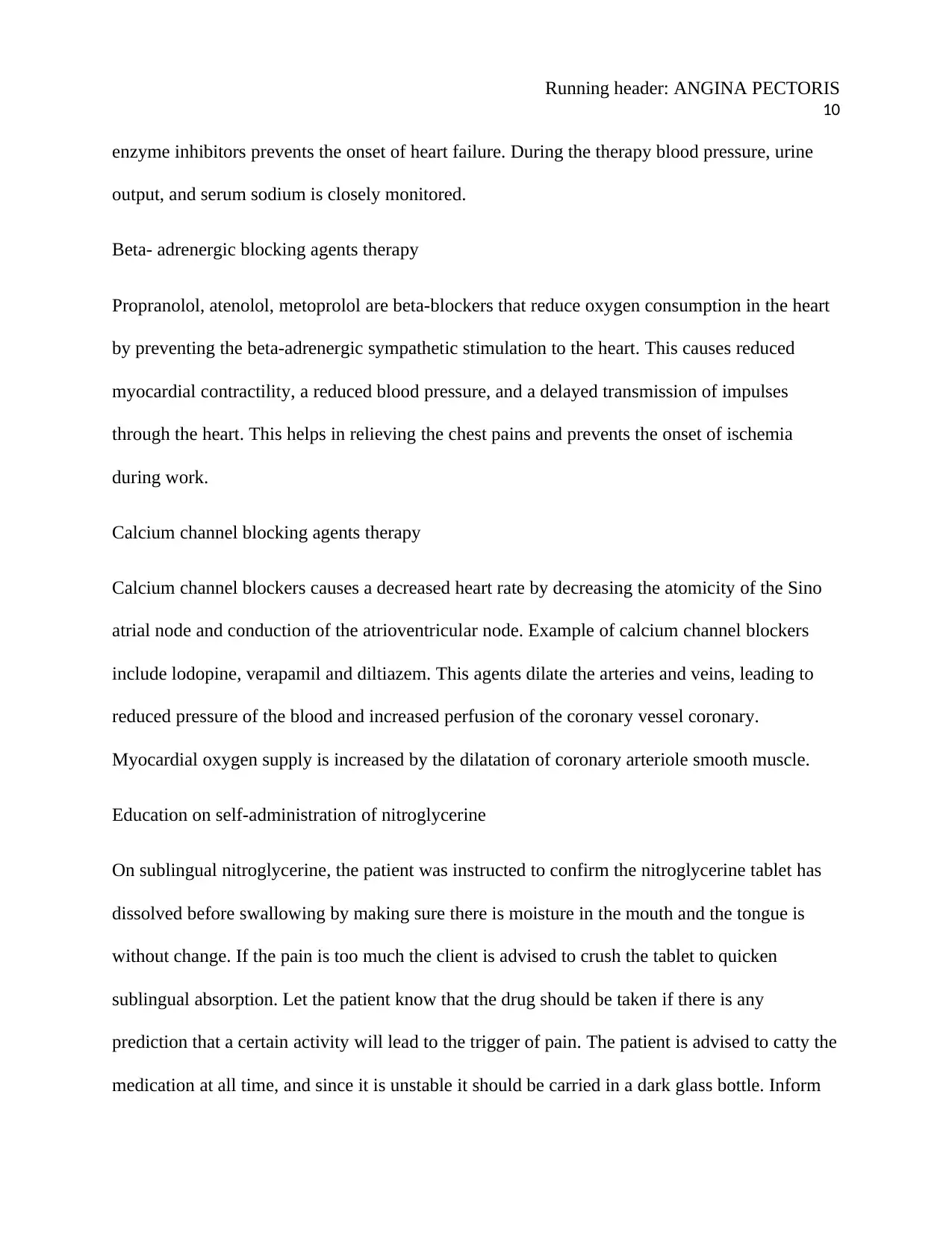
Running header: ANGINA PECTORIS
10
enzyme inhibitors prevents the onset of heart failure. During the therapy blood pressure, urine
output, and serum sodium is closely monitored.
Beta- adrenergic blocking agents therapy
Propranolol, atenolol, metoprolol are beta-blockers that reduce oxygen consumption in the heart
by preventing the beta-adrenergic sympathetic stimulation to the heart. This causes reduced
myocardial contractility, a reduced blood pressure, and a delayed transmission of impulses
through the heart. This helps in relieving the chest pains and prevents the onset of ischemia
during work.
Calcium channel blocking agents therapy
Calcium channel blockers causes a decreased heart rate by decreasing the atomicity of the Sino
atrial node and conduction of the atrioventricular node. Example of calcium channel blockers
include lodopine, verapamil and diltiazem. This agents dilate the arteries and veins, leading to
reduced pressure of the blood and increased perfusion of the coronary vessel coronary.
Myocardial oxygen supply is increased by the dilatation of coronary arteriole smooth muscle.
Education on self-administration of nitroglycerine
On sublingual nitroglycerine, the patient was instructed to confirm the nitroglycerine tablet has
dissolved before swallowing by making sure there is moisture in the mouth and the tongue is
without change. If the pain is too much the client is advised to crush the tablet to quicken
sublingual absorption. Let the patient know that the drug should be taken if there is any
prediction that a certain activity will lead to the trigger of pain. The patient is advised to catty the
medication at all time, and since it is unstable it should be carried in a dark glass bottle. Inform
10
enzyme inhibitors prevents the onset of heart failure. During the therapy blood pressure, urine
output, and serum sodium is closely monitored.
Beta- adrenergic blocking agents therapy
Propranolol, atenolol, metoprolol are beta-blockers that reduce oxygen consumption in the heart
by preventing the beta-adrenergic sympathetic stimulation to the heart. This causes reduced
myocardial contractility, a reduced blood pressure, and a delayed transmission of impulses
through the heart. This helps in relieving the chest pains and prevents the onset of ischemia
during work.
Calcium channel blocking agents therapy
Calcium channel blockers causes a decreased heart rate by decreasing the atomicity of the Sino
atrial node and conduction of the atrioventricular node. Example of calcium channel blockers
include lodopine, verapamil and diltiazem. This agents dilate the arteries and veins, leading to
reduced pressure of the blood and increased perfusion of the coronary vessel coronary.
Myocardial oxygen supply is increased by the dilatation of coronary arteriole smooth muscle.
Education on self-administration of nitroglycerine
On sublingual nitroglycerine, the patient was instructed to confirm the nitroglycerine tablet has
dissolved before swallowing by making sure there is moisture in the mouth and the tongue is
without change. If the pain is too much the client is advised to crush the tablet to quicken
sublingual absorption. Let the patient know that the drug should be taken if there is any
prediction that a certain activity will lead to the trigger of pain. The patient is advised to catty the
medication at all time, and since it is unstable it should be carried in a dark glass bottle. Inform
Paraphrase This Document
Need a fresh take? Get an instant paraphrase of this document with our AI Paraphraser

Running header: ANGINA PECTORIS
11
the patient on the side effects of the medication which includes hypotension, tachycardia and a
throbbing headache.
On topical nitroglycerine the patient is advised to check the instructions since the instructions
change according to preparation. Explain to the client that the application area needs to be well
perfused for proper absorption to occur. Explain to the patient that in order to prevent tolerance
that is when the same amount of medication a long term of topical nitroglycerine should be
avoided.
11
the patient on the side effects of the medication which includes hypotension, tachycardia and a
throbbing headache.
On topical nitroglycerine the patient is advised to check the instructions since the instructions
change according to preparation. Explain to the client that the application area needs to be well
perfused for proper absorption to occur. Explain to the patient that in order to prevent tolerance
that is when the same amount of medication a long term of topical nitroglycerine should be
avoided.
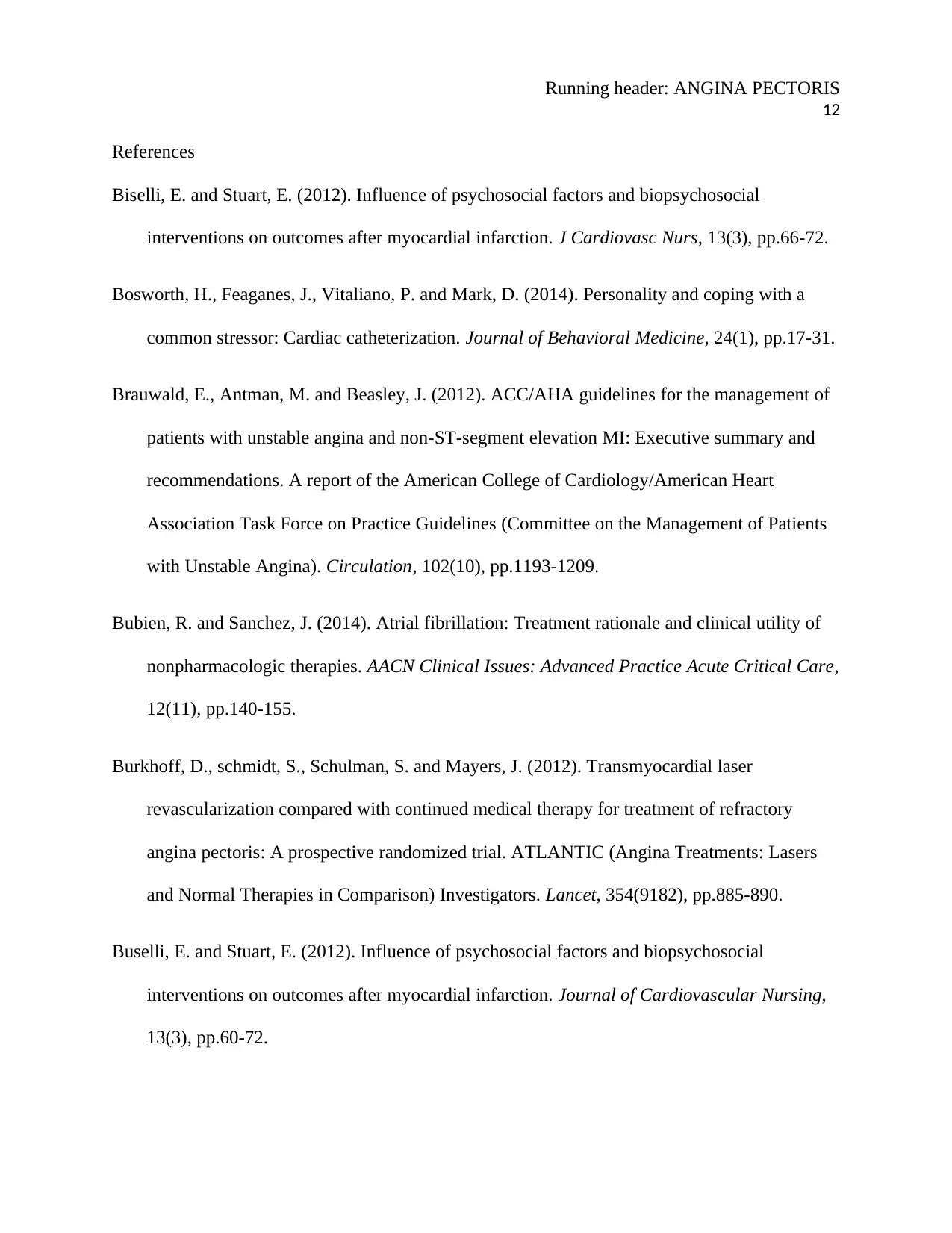
Running header: ANGINA PECTORIS
12
References
Biselli, E. and Stuart, E. (2012). Influence of psychosocial factors and biopsychosocial
interventions on outcomes after myocardial infarction. J Cardiovasc Nurs, 13(3), pp.66-72.
Bosworth, H., Feaganes, J., Vitaliano, P. and Mark, D. (2014). Personality and coping with a
common stressor: Cardiac catheterization. Journal of Behavioral Medicine, 24(1), pp.17-31.
Brauwald, E., Antman, M. and Beasley, J. (2012). ACC/AHA guidelines for the management of
patients with unstable angina and non-ST-segment elevation MI: Executive summary and
recommendations. A report of the American College of Cardiology/American Heart
Association Task Force on Practice Guidelines (Committee on the Management of Patients
with Unstable Angina). Circulation, 102(10), pp.1193-1209.
Bubien, R. and Sanchez, J. (2014). Atrial fibrillation: Treatment rationale and clinical utility of
nonpharmacologic therapies. AACN Clinical Issues: Advanced Practice Acute Critical Care,
12(11), pp.140-155.
Burkhoff, D., schmidt, S., Schulman, S. and Mayers, J. (2012). Transmyocardial laser
revascularization compared with continued medical therapy for treatment of refractory
angina pectoris: A prospective randomized trial. ATLANTIC (Angina Treatments: Lasers
and Normal Therapies in Comparison) Investigators. Lancet, 354(9182), pp.885-890.
Buselli, E. and Stuart, E. (2012). Influence of psychosocial factors and biopsychosocial
interventions on outcomes after myocardial infarction. Journal of Cardiovascular Nursing,
13(3), pp.60-72.
12
References
Biselli, E. and Stuart, E. (2012). Influence of psychosocial factors and biopsychosocial
interventions on outcomes after myocardial infarction. J Cardiovasc Nurs, 13(3), pp.66-72.
Bosworth, H., Feaganes, J., Vitaliano, P. and Mark, D. (2014). Personality and coping with a
common stressor: Cardiac catheterization. Journal of Behavioral Medicine, 24(1), pp.17-31.
Brauwald, E., Antman, M. and Beasley, J. (2012). ACC/AHA guidelines for the management of
patients with unstable angina and non-ST-segment elevation MI: Executive summary and
recommendations. A report of the American College of Cardiology/American Heart
Association Task Force on Practice Guidelines (Committee on the Management of Patients
with Unstable Angina). Circulation, 102(10), pp.1193-1209.
Bubien, R. and Sanchez, J. (2014). Atrial fibrillation: Treatment rationale and clinical utility of
nonpharmacologic therapies. AACN Clinical Issues: Advanced Practice Acute Critical Care,
12(11), pp.140-155.
Burkhoff, D., schmidt, S., Schulman, S. and Mayers, J. (2012). Transmyocardial laser
revascularization compared with continued medical therapy for treatment of refractory
angina pectoris: A prospective randomized trial. ATLANTIC (Angina Treatments: Lasers
and Normal Therapies in Comparison) Investigators. Lancet, 354(9182), pp.885-890.
Buselli, E. and Stuart, E. (2012). Influence of psychosocial factors and biopsychosocial
interventions on outcomes after myocardial infarction. Journal of Cardiovascular Nursing,
13(3), pp.60-72.
⊘ This is a preview!⊘
Do you want full access?
Subscribe today to unlock all pages.

Trusted by 1+ million students worldwide
1 out of 14
Your All-in-One AI-Powered Toolkit for Academic Success.
+13062052269
info@desklib.com
Available 24*7 on WhatsApp / Email
![[object Object]](/_next/static/media/star-bottom.7253800d.svg)
Unlock your academic potential
Copyright © 2020–2026 A2Z Services. All Rights Reserved. Developed and managed by ZUCOL.